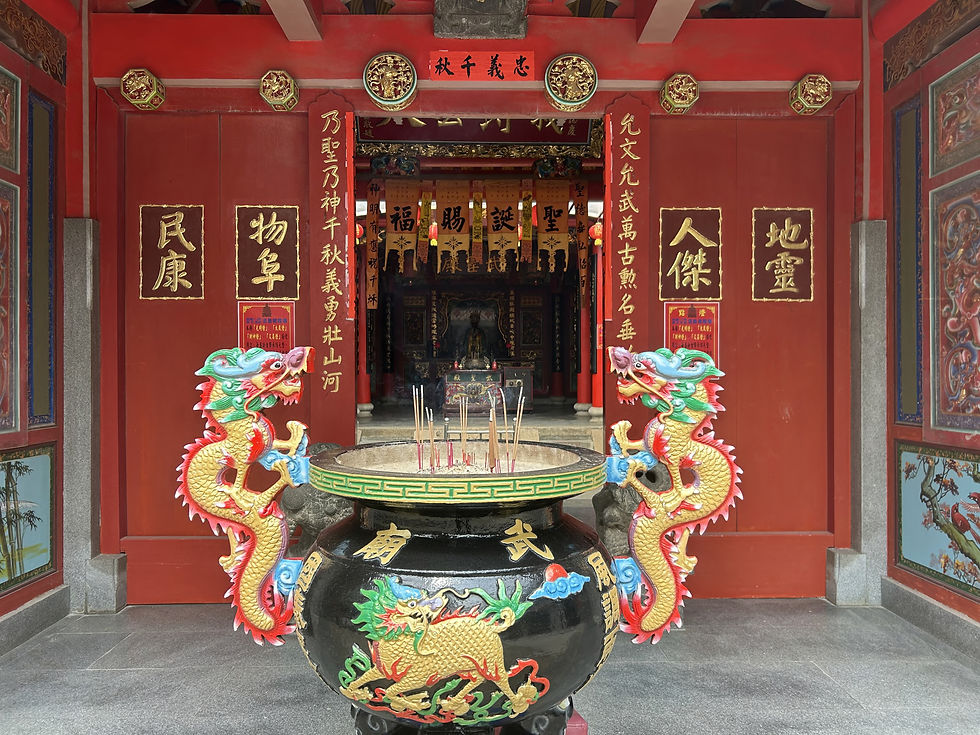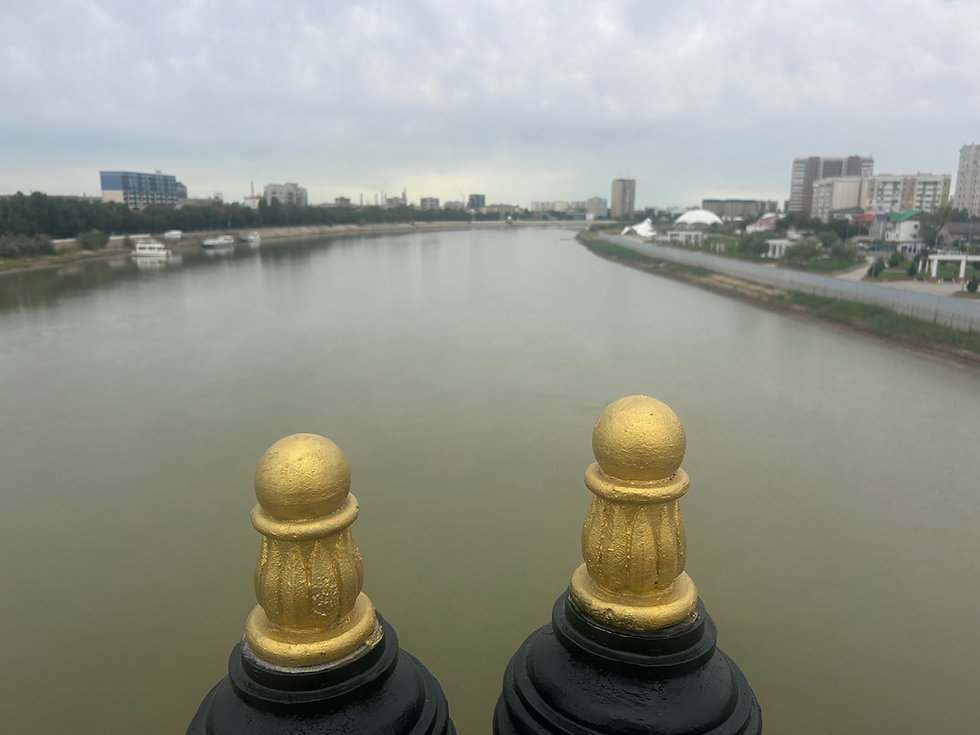Facing China virtually: the Islands of Kinmen and Matsu
- Wolfgang Fobo
- 6. Mai 2024
- 6 Min. Lesezeit
Aktualisiert: 13. Mai

I felt some kind of urgency. Visiting these islands as long as they pertain to the Taiwanese government while Taiwan is threatened by the Chinese government of an invasion. Or, to put it mildly, a reunification by way of military force. So I was curious how the Taiwanese keep these islands which are just a few kilometers off the Chinese coast under their control.
Reaching the islands is not a big deal, there are several flights a day from Taipei Songshan airport - provided that weather allows - and Matsu you can even reach by ferry from Keelung. I preferred to fly - it takes you less than an hour to reach these islands, and flying is not really expensive either.
But flying to these outlying islands is accompanied with a big risk, as I learned the hard way. In April there is often fog, and once there is fog, the flights are cancelled. Then you get stuck, at least if the bad luck strikes you in Kinmen - flying there is the only option.

So my advice is: Plan enough extra time. It happened to me that the return flight from Kinmen to Taipei was cancelled. While we were waiting for the arrival of the airplane from Taipei, all of a sudden the flight was cancelled. Because of bad weather. Indeed it turned more and more foggy. But in my view not that foggy that the airport should close. But it closed…
So we had to reschedule our flight. And find another accommodation, as my flight was rescheduled to next morning. I called my host, and luckily he had another room for me, picked me up from the airport and even left to me his car such that I could drive to the airport myself early next morning. Leaving the car there unlocked at the parking lot (he said it would be safe, and he would pick up his car later that day). The rescheduled flight was also cancelled, and the queue for flying standby for the next available flights got longer and longer. Finally I was lucky, I don’t know why: the lady at the counter gave me the last available seat on the afternoon flight which was confirmed to leave, I felt like having won the lottery, and with a delay of some 33 hours finally I touched down in Taipei.
So my lesson learned when travelling to an outlying island is:
leave enough extra time for unforseen circumstances. Which I did. Caused by the cancellations on Kinmen I could even reschedule my flight to the even more remote island of Matsu which is said to be even more prone to cancellations. I left an extra of 2 spare days just in case I could not leave in time.
In Kinmen people trust you more than I was used to be trusted. Ok, I cannot disappear with a car on this little island, but would you leave your car to somebody whom you just met?
Language
There are almost no Western tourists on the islands, just mainland Chinese and Overseas Chinese, and so very few speak English. Since I can get along in Chinese language, I never felt a problem in getting around or in overcoming all the hassle with the cancelled flights: all my communication was in Chinese, and I believe that my hosts spoke very little English, if at all. Anyhow, if you speak no Chinese, you may muddle through one way or the other, but it will be a major challenge. For sightseeing you need a vehicle, and If you don’t drive a car you will need a tourist bus, and the regular guided tours are all in Chinese language. On Kinmen, I could use the car of my host to get around, and on Matsu I took the guided tour in a tourist bus.

What works very well is communicating in Chinese in writing. Communicating in writing with my hosts, I used the DeepL App. So I texted my messages in German language which DeepL right away translates into Chinese. Then you just do „copy and paste“, either via WhatsApp or with the message service of booking.com, and so I was always well in the picture what my hosts wanted to let me know, or what I wanted to let them know (I confess that talking in Chinese is ok for me, but for writing I don’t know all the Chinese characters necessary…). Oh, I almost forgot to mention that I bought an eSim for Taiwan - costs you practially nothing, and you are online all the time. And this was indeed necessary when bad luck strikes you.

Politics
As we can read almost every day, the Chinese government threatens Taiwan with an invasion. And with Kinmen being closest to mainland China - just about 3km - I thought the trouble would start here. So I asked my host whether he would feel unsafe, being so close to his big brother. Not at all, he replied. Rather the Kinmen people would like to join China, they feel to belong to the province of Fujian, and not being real Taiwanese. It is rather the Taiwanese government that keeps Kinmen on its side. So, certainly the trouble would not start here, the Chinese government is aware of the desire of the Kinmen people to unite with China. And yes, there is a ferry service to Xiamen that brings you there in 30 minutes, and my host has been over there many times already.

Military
Military installations are ubiquitous, and you will see them for sure. The islands are full of bunkers, forts, caves and other protection like stakes or spikes planted at the beach to prevent or at least inhibit landing of the Chinese military. Due to the thawing of relations in the 1990s, many of these installations were converted into museums or sight seeing spots, so you can get a very good impression of the defensive preparations. The real Taiwanese military was nowhere to be seen, but I bet they are well established and well hidden, to defend the islands in case of a possible attack.
Culture
Apart from the military installations that make these islands unique, you visit the old China, unspoiled by the devastations of a cultural revolution. You will see lots of old temples, and in Matsu Nangan island you can worship the Sea goddess Mazu. Then many houses are still kept in old Fujian architecture - my guesthouse in Kinmen was of that kind, and I enjoyed staying in old historical architecture (Aircon and bathroom of present day style, of course) .

People
Both on Kinmen and Matsu Nangan I stayed in a B&B, and so had lots of opportunity to communicate with my hosts. I don’t know whether I was exceptionally lucky, but I cannot remember having had such friendly hosts anywhere. Same with waiters, shop keepers, anybody…

Toilets
It does not apply only to Kinmen or Matsu, but to all over Taiwan: everywhere you will find spotlessly clean toilets, free of charge. Incredible. In comparison, Germany is in a developing stage, going backward (here in Germany you mostly have to pay, and very often you need coins, as credit cards are rarely accepted. Not really a customer friendly policy, if the customer is under some urgency….). In this respect, I cannot praise Taiwan highly enough.

Prices
Less than you may think. A public bus in Kinmen sets you back some 0.6 USD, similar in Matsu Nangan. Even the tour bus on Matsu Nangan island that shows you around the island over perhaps 3-4 hours will not cost more than 10 USD.
Remains to say that even flying to and from Kinmen or Matsu does not cost more than around 80 USD one way, and the Taima ferry to Matsu is even cheaper and saves you a night in a guesthouse or hotel.

To summarise, if you are interested in geopolitics, this is a perfect place to get acquainted with the situation between Taiwan and its big brother to the West.



Kommentare